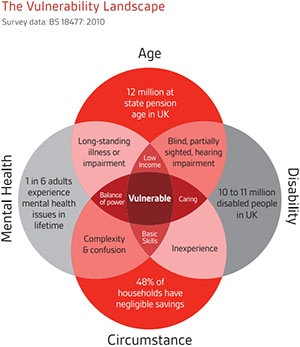Q: Why is providing inclusive services important?
Matthew Scott: Organizations that understand consumer vulnerability, and provide an inclusive and flexible approach, are better able to meet a diverse range of consumer needs, making it easier for consumers to access information, services and products, make good decisions and achieve positive outcomes.
The benefits are not confined to your customers and clients. Your organization will also reap rewards, from increasing your market share and boosting your performance to enhancing your social value and brand reputation by contributing to United Nations’ sustainable development goals (SDGs), particularly the SDG 5 on equality and SDG 10 on inequality. This all adds up to ensuring you are future ready.
Q: How can organizations create fair, respectful, and inclusive services?
Matthew Scott: There is a best practice guide that set this out, the inclusive service verification standard BS 18477.
To give it its full title, BS 18477, inclusive service provision – Requirements for identifying and responding to consumer vulnerability, provides a practical framework (or ‘how to’ guide, if you like) for organizations and their employees to understand the underlying factors involved in consumer vulnerability, and work to develop processes to address the barriers to inclusion.
It has been designed specifically to help organizations identify vulnerable consumers and adapt their services to be inclusive and accessible to everyone. It recognizes that all consumers are different and that these differences can put some in a position of vulnerability or disadvantage (harm) during certain transactions and communications. For example, consumers with a hearing impairment could be particularly vulnerable to an advertising campaign that claims that a mobile phone is ‘hearing aid compatible’.
The standard specifies requirements and gives guidance for organizations on how to provide an inclusive service at all stages of service delivery, helping them to identify and support consumers in vulnerable situations.
 Q: What exactly is meant by ‘vulnerability’?
Q: What exactly is meant by ‘vulnerability’?
Matthew Scott: Vulnerability can affect anyone at any time. All consumers are different, with widely varying personal characteristics and circumstances, from their age, health and wealth to their abilities (such as literacy) and other needs (such as hearing loops or translation.) These variable factors, combined with the impact of life events and external conditions – the pandemic is a good example, plus organizational behaviour, can result in consumers being placed in a vulnerable situation, increasing the risk of them experiencing harm when dealing with organizations.
Vulnerability can be permanent, temporary, sporadic, long or short term. A consumer’s needs and abilities can change over time, or very rapidly if they are faced with an unexpected change of circumstance or a particularly urgent or complex situation. We have seen this at first-hand during the COVID-19 pandemic. There are many people who would not previously have considered themselves to be vulnerable, but who suffered setbacks in the pandemic, such as unemployment, ill-health and isolation, that put them at risk.
Q: What is the role of senior management in creating the culture of care and trust needed to provide inclusive service?
Matthew Scott: The role of top management is to demonstrate a clear commitment to improving outcomes for consumers in vulnerable situations, and to minimizing the risk of consumer harm by following the principles detailed in the standard. Top management must then embed this commitment across the organization through the ongoing engagement, communication and training of staff to ensure that potentially vulnerable customers are identified and served appropriately.
Q: Which sectors or organizations are currently using this standard and why?
Matthew Scott: UK utility providers and their regulatory bodies have recognized the importance of the issue of vulnerable consumers within the sector, and the benefits of adopting BS 18477. Compliance targets set by regulators such as OFGEM will include a performance commitment to achieving certification to the standard.
As for why organizations are adopting an inclusive service approach, it is quite simply because it offers them many potential benefits, including:
- A larger customer base by making services accessible to more people
- An improvement in the quality of consumer interactions, and reduced risk of harm
- Less likelihood of problems and customer complaints, and reduced cost of dealing with them, by getting things right first time
- Improved customer satisfaction, building consumer trust
- Progress towards sustainable business goals such as ethical behaviour and social responsibility
- Enhanced organizational reputation
- Strengthened staff loyalty and engagement by ensuring that they feel valued, supported and confident in handling difficult situations
- Easier compliance with legal obligations related to fairness and equality, by following good practice in the fair treatment of consumers in vulnerable situations
Q: What would be your top tips for organizations?
Matthew Scott: There are initially 6 steps that I would recommend:
- Assessing the impact of products and services – where could harm arise?
- Supporting employees – do they understand the vulnerabilities, have they been trained, and do they have the right tools?
- Working in partnership – reach out to charities and community groups, as they have a lot of great advice and can provide awareness training for your own organization on vulnerabilities and issues affecting the local community
- Getting the basics right – starting with the service or product. A well designed, good quality product or service plus great customer service is beneficial for everyone
- Simplified products and services – too many products, services or tariffs are complex to navigate
- Customer segmentation – having a better understanding of your different customers to ensure that you are not only offering the right products and services, but you have a better understanding of their needs and vulnerabilities.
As an assessor of the standard, I would also recommend reaching out to organizations that already demonstrate best practice and are using BS 18477. I see many organizations collaborating on improvements within their communities and sectors.
Q: BS 18477 is set to become the international standard ISO 22458 in 2022. What impact do you think this will have?
Matthew Scott: It is great that another British Standard is being adopted internationally, it really demonstrates how BSI helps improve society. Becoming an ‘ISO’ will increase organizations’ awareness of the standard and the benefits they can derive from it and support vulnerable consumers around the world. I think we will also see more sectors finding benefits from this best practice guide. While utility companies have been the main users of the standard so far, other industries are starting to see its value, including debt collection, enforcement, mobility and transportation, retail and financial services such as banking and insurance.







